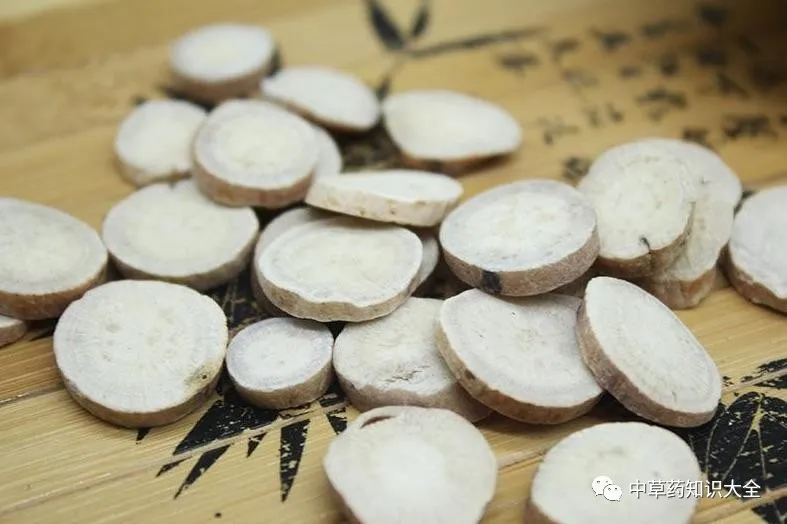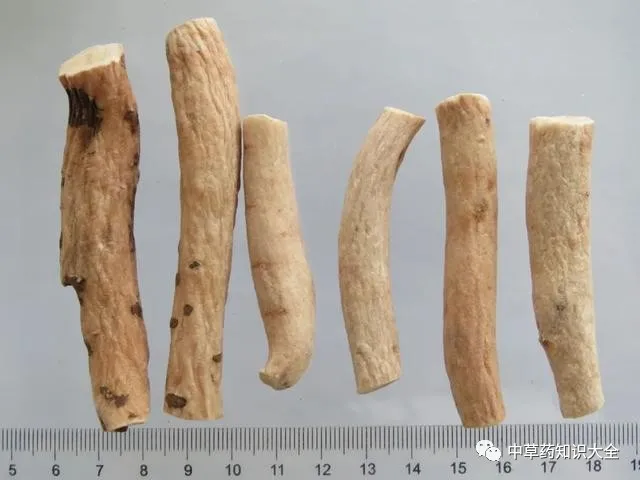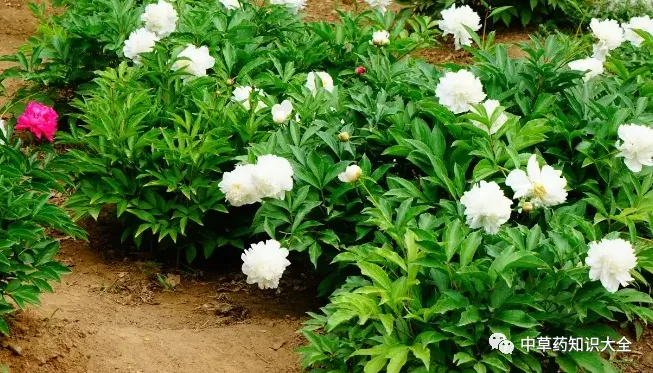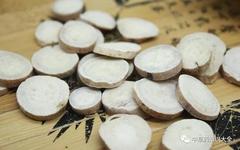PinyinBái Sháo

AliasJin Shao Yao (金芍药) (from “Anqi Sheng Fu Lian Fa”), Bai Shao (白芍) (from “Yao Pin Hua”).
SourceFrom the root of the peony plant (Paeonia lactiflora), a member of the Ranunculaceae family. The roots are harvested in summer and autumn from plants that have been cultivated for 3-4 years, removing the rhizome and fibrous roots, washing them, scraping off the rough skin, and briefly boiling in water to soften the roots before drying.

Habitat DistributionGrows in shrubbery or grasslands on hillsides and in valleys. Distributed in Heilongjiang, Jilin, Liaoning, Hebei, Henan, Shandong, Shanxi, Shaanxi, Inner Mongolia, and other regions. Cultivated throughout the country.
Original FormPaeonia (《诗经》), also known as Li Cao (离草) (from “Han Shi Neichuan”), Yu Rong, Qi Ji, Jie Cang (《吴普本草》), Ke Li (Cui Bao’s “Gu Jin Zhu”), Li Shi, Xuan (《别录》), Mo Gu Hua (《胡本草》), Lan Wei Chun (《清异录》), Jiang Li (《纲目》).
Perennial herb, 50-80 cm tall. The root is thick, usually cylindrical or slightly spindle-shaped. The stem is erect, smooth, and hairless. Leaves are alternate; with long petioles; 2-3 times pinnate compound leaves, leaflets are oval to lanceolate, 8-12 cm long, 2-4 cm wide, with a gradually pointed or sharp tip, wedge-shaped at the base, entire margin, with very fine papillae on the leaf edge, dark green above, light green below, with raised veins underneath, and often reddish at the base. Flowers are very large, solitary at the top of the flower stem, with 2-5 flowers per stem, stem length 9-11 cm; sepals 3, leaf-like; petals about 10 or more, obovate, white, pink, or red; numerous stamens, anthers yellow; 3-5 carpels, separate. The fruit is a follicle with 3-5 segments, oval, with a hooked tip bending outward. Flowering period is from May to July. Fruit ripens from June to July.

CharacteristicsThe dried root is cylindrical, uniform in thickness, straight, 10-20 cm long, and 1-1.8 cm in diameter. The surface is light reddish-brown or pale white, flat, or with obvious longitudinal wrinkles and fibrous root marks, with brownish spots where the cork layer has not been completely removed, occasionally with transverse pores. The texture is solid and heavy, not easily broken. The cross-section is grayish-white or slightly brown, with radiating wood fibers resembling a chrysanthemum heart. It is odorless and has a slightly bitter and sour taste. The best quality is characterized by a thick, long, straight root, solid texture, sufficient powdery quality, and a clean surface.
Mainly produced in Zhejiang, Anhui, Sichuan, and other regions. Additionally, Shandong, Guizhou, Hunan, Hubei, Gansu, Shaanxi, Henan, Yunnan, and other areas also produce it. The Zhejiang product is known as Hang Bai Shao, which has the best quality; the Anhui product is called Bo Bai Shao, which has the largest yield; the Sichuan product is named Chuan Bai Shao, also known as Zhongjiang Shao, which is also produced in large quantities.
The name Bai Shao was first recorded in the “Shen Nong Ben Cao Jing” and was classified into two types: Bai Shao Yao (白芍药) and Chi Shao Yao (赤芍药). Currently, Bai Shao Yao is mostly cultivated, while Chi Shao Yao is mostly wild, but in some areas, such as Baoji in Shaanxi, the Bai Shao produced is also wild and used as Bai Shao. The root strips are thin, bent, and vary in size, with many cork and fibrous root marks, loose texture, small powdery quality, and indistinct cross-section rays, indicating lower quality.
Chemical CompositionThe root contains paeoniflorin, peony phenol, and paeoniflorin glycosides, with benzoic acid approximately 1.07%, volatile oil, fatty oil, resin, tannins, sugars, starch, mucilage, proteins, β-sitosterol, and triterpenes. Additionally, the Sichuan product contains an acidic substance that inhibits Staphylococcus aureus.
The flowers contain astragaloside, kaempferol 3,7-diglucoside, a large amount of gallic acid (over 10%), pyrethrin 0.13%, 13-methyl-tetradecanoic acid, β-sitosterol, and pentacosane. The leaves contain tannins.
Pharmacological EffectsHas antibacterial properties.
PreparationBai Shao: Remove impurities, separate by size, soak in water until 80% translucent, remove, dry, moisten until internal and external moisture are uniform, slice, and dry. Jiu Bai Shao: Take Bai Shao slices, spray evenly with yellow wine, slightly moisten, and stir-fry in a pot over low heat, then remove and cool. (For every 100 jin of Bai Shao slices, use 10 jin of yellow wine.)
Chao Bai Shao: Take Bai Shao slices, stir-fry in a pot over low heat until slightly yellow, remove and cool. Jiao Bai Shao: Take Bai Shao slices, stir-fry in a pot over high heat until charred yellow, spray with a little clear water, remove, and dry. Tu Chao Bai Shao: Take Fulong Gan fine powder, heat in a pot, add Bai Shao slices; stir-fry until the outside has a soil color, remove, sift out the soil, and cool. (For every 100 jin of Bai Shao slices, use 20 jin of Fulong Gan fine powder.)
① “Lei Gong Pao Zhi Lun”: “After harvesting Bai Shao Yao, dry it in the sun at noon, scrape off the rough skin and head soil with a bamboo knife, chop it, mix with honey water, steam, and dry from the time of the si to the wei (from 9 AM to 11 AM).”
② “Ben Cao Meng Quan”: “(Bai Shao Yao) soak in wine and sun, do not expose to fire.”
Meridian EntryEnters the Liver and Spleen meridians.
① “Pin Hui Jing Yao”: “Acts on the Hand Taiyin and Foot Taiyin meridians.”
② “Ben Cao Jing Shu”: “A meridian medicine for Hand and Foot Taiyin, enters the blood of the Liver and Spleen.”
Properties and FlavorBitter and sour, cool.
① “Ben Jing”: “Taste is bitter, neutral.”
② “Wu Pu Ben Cao”: “Tong Jun: Sweet, non-toxic. Qi Bo: Salty. Li Shi: Slightly cold. Lei Gong: Sour.”
③ “Bie Lu”: “Sour, neutral, slightly cold, with slight toxicity.”
PrecautionsUse with caution in cases of deficiency cold abdominal pain and diarrhea.
① “Ben Cao Jing Ji Zhu”: “Must (one version says ‘Lei’) use pills for it. Avoid Shi Hu, Mang Xiao. Fear of Xiao Shi, Bie Jia, Xiao Ji. Counteracts Li Lu.”
② “Ben Cao Jing Shu”: “In cases of cold abdominal pain, cold causing diarrhea, cold pain in the abdomen, feeling cold in the intestines and stomach, etc., avoid it.”
③ “Yao Pin Hua Yi”: “Avoid in cases of rashes.”
④ “De Pei Ben Cao”: “For spleen qi deficiency and pure blood diarrhea, do not use.”
Functions and IndicationsNourishes blood, softens the liver, alleviates pain, and restrains yin and stops sweating. Treats chest, abdominal, and hypochondriac pain, diarrhea, abdominal pain, spontaneous sweating, night sweats, yin deficiency heat, irregular menstruation, metrorrhagia, and leukorrhea.
① “Ben Jing”: “Mainly treats abdominal pain due to evil qi, removes blood stasis, breaks up hard accumulations, treats cold and heat hernias, stops pain, benefits urination, and tonifies qi.”
② “Bie Lu”: “Smooths blood vessels, alleviates pain, disperses evil blood, expels stagnant blood, removes water qi, benefits the bladder, large and small intestines, and resolves abscesses, treats seasonal cold and heat, and abdominal pain due to evil qi.”
③ “Yao Xing Lun”: “Treats lung evil qi, abdominal pain due to masses, blood qi accumulation, opens and regulates the viscera, treats evil pain and blood stasis, mainly treats seasonal diseases, bone heat, strengthens the five organs, tonifies kidney qi, treats abdominal distension, women’s blood blockage, expels blood stasis, and can dissolve pus.”
④ “Tang Ben Cao”: “Benefits women’s blood.”
⑤ “Ri Hua Zi Ben Cao”: “Treats wind, tonifies tuberculosis, mainly for all women’s diseases, and various ailments before and after childbirth, regulates menstruation, reduces fever, relieves irritability, tonifies qi, treats seasonal heat diseases, pestilence, mania, women’s blood circulation, and intestinal wind diarrhea, hemorrhoids, sores, headaches, improves vision, redness of the eyes, and pterygium.”
⑥ “Yi Xue Qi Yuan”: “Calms the spleen, treats abdominal pain, collects stomach qi, stops diarrhea, benefits, harmonizes blood, consolidates the pores, drains the liver, and tonifies the spleen and stomach.”
⑦ Wang Hao Gu: “Regulates the middle qi, treats spleen deficiency and fullness, heart distension, pain under the ribs, good belching, lung distension, and cough, nasal bleeding, dry eyes, insufficient liver blood, yang wei disease with cold and heat, and pain in the abdomen with fullness, feeling like sitting in water.”
⑧ “Dian Nan Ben Cao”: “Drains spleen heat, stops abdominal pain, stops diarrhea, restrains liver qi counter pain, nourishes heart, liver, and spleen blood, smooths meridians, lowers qi, and stops liver qi pain.”
Dosage and AdministrationInternal use: decoction, 2-4 qian; or in pills or powders.
Formulas① For treating women’s hypochondriac pain: Xiang Fu Zi 4 liang (with 2 bowls of yellow vinegar, 1 liang of salt, cooked until dry), Rou Gui, Yan Hu Suo (stir-fried), Bai Shao. Grind into a fine powder, take 2 qian each time, decoct in boiling water, taken at any time. (From “Zhu Shi Ji Yan Yi Fang” Shao Yao Decoction)
② For treating dysentery with pus and blood, urgency, and heaviness: Bai Shao 1 liang, Dang Gui 0.5 liang, Huang Lian 0.5 liang, Bing Lang, Mu Xiang 2 qian; Gan Cao 2 qian (stir-fried), Da Huang 3 qian, Huang Qin 0.5 liang, Guan Gui 2.5 qian. Finely chop, take 0.5 liang, with 2 cups of water, decoct until 1 cup remains, take warm after meals. (From “Su Wen Bing Ji Bao Ming Ji” Shao Yao Decoction)
③ For treating abdominal masses during pregnancy: Dang Gui 3 liang, Bai Shao 1 jin, Fu Ling 4 liang, Bai Zhu 4 liang, Ze Xie 0.5 jin, Chuan Xiong 0.5 jin (or 3 liang). Grind these six ingredients into a powder. Take a small spoonful mixed with wine, three times a day. (From “Jin Kui Yao Lue” Dang Gui Bai Shao San)
④ For treating postpartum blood qi attacking the heart and abdominal pain: Bai Shao 2 liang, Gui (remove rough skin), Gan Cao (roasted) each 1 liang. Grind these three ingredients, take 3 qian each time, with 1 cup of water, decoct until 7 parts remain, remove dregs, take warm, no time restriction. (From “Sheng Ji Zong Lu” Shao Yao Decoction)
⑤ For treating dysmenorrhea: Bai Shao 2 liang, Gan Jiang 8 qian. Grind into a fine powder, divide into eight packets, take one packet daily during menstruation, with yellow wine as a guide, for three consecutive weeks. (From Inner Mongolia “Chinese Herbal Medicine New Medical Method Compilation”)
⑥ For treating chronic leukorrhea: Bai Shao 3 large liang, Gan Jiang 0.5 large liang. Finely chop, fry until yellow, pound and sift. Take 2 qian empty stomach, twice a day. (From “Guang Li Fang”)
⑦ For treating bleeding from wounds: Bai Shao 1 liang, fry until yellow, grind finely into powder. Take 2 qian with wine or rice wine. Take three times initially, gradually increase. (From “Guang Li Fang”)
⑧ For treating edema and pain in the feet: Bai Shao 6 liang, Gan Cao 1 liang. Grind into powder, take with white soup. (From “Sui Shi Guang Ji”)
⑨ For treating pain from wind toxin in the bones and marrow: Bai Shao 2 fen, Hu Gu 1 liang (roasted). Grind into powder, place in a silk bag, soak in 3 sheng of wine for five days. Take 3 he each time, three times a day. (From “Jing Yan Hou Fang”)
Excerpt from “Chinese Herbal Medicine Dictionary”
 Note:This account aims to promote traditional Chinese medicine culture, and the TCM knowledge mentioned in the text is for learning and exchange purposes only.
Note:This account aims to promote traditional Chinese medicine culture, and the TCM knowledge mentioned in the text is for learning and exchange purposes only.
WeChat has been updated! If youneither★starred me nor have liked or “looked at” my articles,the system will assume you do not wish to receive information related to herbal medicine knowledge, and ultimatelyyou will not receive our article updates
End of text. Thank you for your patience in reading. If you find it appealing, please click “ like” and “
like” and “ look” button at the bottom~
look” button at the bottom~

